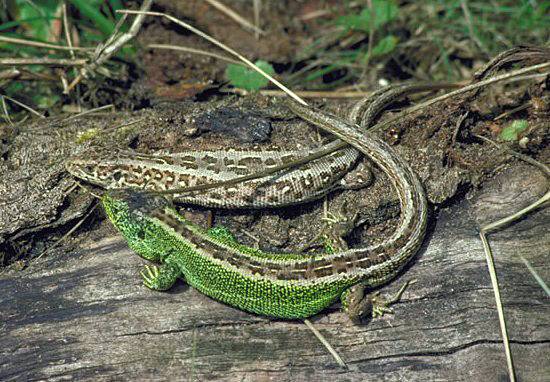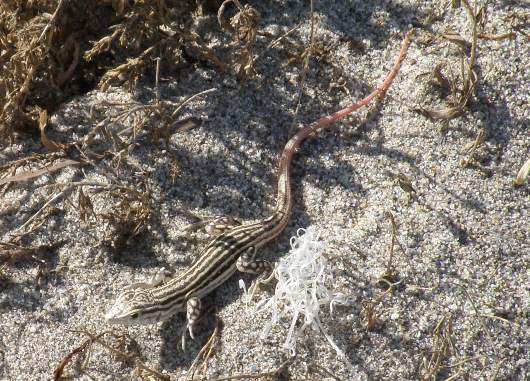Trees Birds Mammals Fish Amphibians Reptiles
Wild Algarve
Bookshop
Lacerta agilis - Sand Lizard
Phylum: Chordata - Class: Reptilia - Order: Squamata - Family: Lacertidae
Identification - Distribution - Lifecycle - Food - Threats - Reference Sources

Despite its distinctive colouring the rare and very shy Sand Lizard is seldom seen in Britain.
Identification
At up to 9cm in body length and more than 20cm from head to tail, the Sand Lizard is actually
quite a bit bigger than the Common Lizard, Lacerta
vivipara. The mle in its breeding colours is particularly brightly coloured, with attractive
occeli (eye-shaped markings) and green flanks.

Distribution
Thanks to a reintroduction programme in southern Britain, this lovely lizard is now found in a few coastal sand dunes, although there are also native Sand Lizard colonies in a few sandy heathlandsites in Surrey, Hampshire aand Dorset (southern England). Sand LIzards are far more common in parts of eastern Europe.
Lifecycle
Unlike many other reptiles, the Sand Lizard is oviparous rather than vivaporous. Emerging from hibernation in March or early April, after mating the female lays her eggs under a shallow layer of sand. The eggs are simply left to hatch by the warmth of the summer sun, and the juveniles, typically 6cm long, emerge in August or September.
Food
During the day, Sand Lizards feed on insects and other small invertebrates; by night they rest in shallow burrows dug in the sand.
Threats
Habitat loss is generally considered to be the main cause
of the decline in numbers of Sand Lizards. The natural populations were
apparently lost from the sand dunes of North Wales and Merseyside and from
the New Forest, although programmes of work to reintroduce them have
provided encouraging results in recent years; and a re-introduction to the
Inner Hebrides in the early 1970s appears to have resulted in a self-sustaining population.

Above: the Fringe-fingered Lizard Acanthodactylus erythrurus is a southern European reptile of sandy coastal habitats.
As the common name implies, the habitat needs of these
lizards are for dry sandy places such as sand dunes and sandy heathland. Many sites of suitable habitat in Britain have been damaged or destroyed in recent times.
The Wildlife and Countryside Act provides very strict
protection for this lizard, which in Britain is considered to be
threatened with extinction. If you come across Sand Lizards you are not
allowed to handle or even disturb them.
Reference Sources
Matching the Hatch by Pat O'Reilly (1997) - learn all about aquatic insects and other small water creatures that feature in the diet of reptiles.
Acknowledgements
This page includes pictures kindly contributed by The Countryside Council for Wales and by Bob Osborne.
Sue Parker's latest ebook is a revised and enlarged second edition of the acclaimed Wildflowers in the Algarve - an introductory guide. Full details here...
Buy it for just £3.95 on Amazon...
Sue Parker's 5-star acclaimed field guide to the Wild Orchids of the Algarve is now available as an ebook. Full details here...
Buy it for just £5.95 on Amazon...
Please Help Us: If you have found this information interesting and useful, please consider helping to keep First Nature online by making a small donation towards the web hosting and internet costs.
Any donations over and above the essential running costs will help support the conservation work of Plantlife, the Rivers Trust and charitable botanic gardens - as do author royalties and publisher proceeds from books by Pat and Sue.